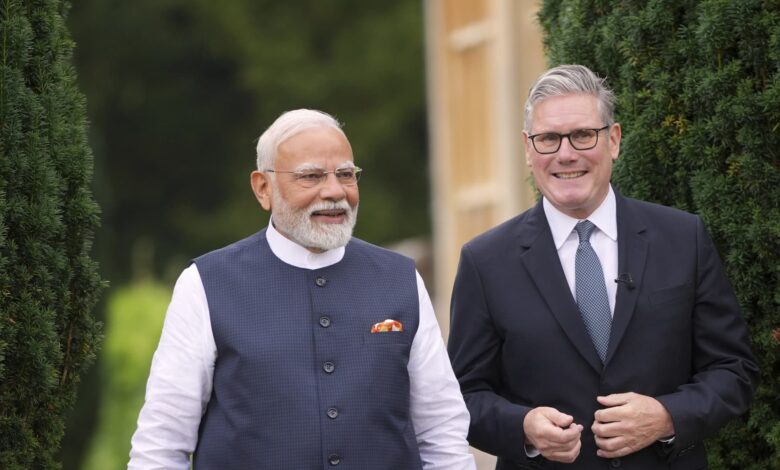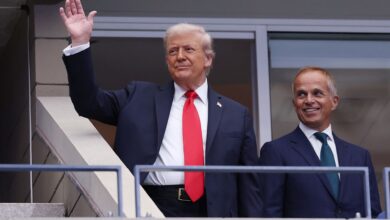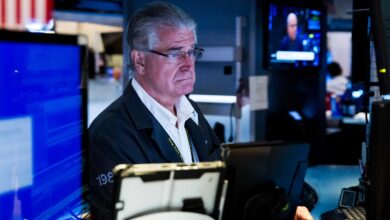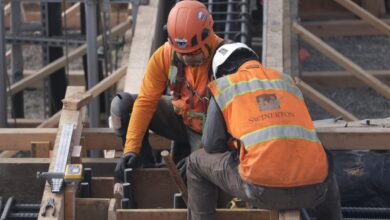Textiles to whisky: U.K.–India ‘historic’ deal is set to boost bilateral trade by over $34 billion a year

AYLESBURY, ENGLAND – JULY 24: UK Prime Minister Keir Starmer and Prime Minister Narendra Modi of India walk in the grounds at Chequers on July 24, 2025 in Aylesbury, England.
Kin Cheung | Getty Images News | Getty Images
U.K. and India’s bilateral trade is set to get a more than $34 billion annual boost over the long term following their free trade agreement, with the countries’ leaders calling it a “historic” deal.
The FTA, which slashes duties on goods including textiles, alcohol and automobiles, was signed Thursday in the presence of Indian Prime Minister Narendra Modi and his UK counterpart, Keir Starmer.
Both sides had finalized the trade pact in May after three years of intense negotiations — marked by thorny issues such as visas, tariff reduction and tax breaks. Talks gained momentum and both governments accelerated to seal the deal as U.S. President Donald Trump’s tariff threats sent the world in disarray.
The agreement between the world’s fifth and sixth largest economies is expected to boost their bilateral trade by 25.5 billion pounds per year by 2040. Trade in goods and services stood at over 40 billion pounds in 2024.
The deal offers “huge benefits to both of our countries,” boosting wages, raising living standards and bringing down prices for consumers, Starmer said.
India’s Modi lauded the agreement as “a blueprint for our shared prosperity,” highlighting how Indian goods including textiles, jewelry, agricultural products and engineering items would benefit from a better access to the U.K. market.
As part of the deal, 92% of goods exported by U.K. to India will see tariffs either removed entirely or reduced, while as much as 99% of Indian goods shipped to Britain will be exempt from tariffs.
The U.K.–India trade pact marked a “strategic win” for New Delhi’s trade diplomacy as it brings targeted benefits to Indian goods that previously faced high tariffs or regulatory barriers, said Dhiraj Nim, an economist at ANZ Bank.
The U.K. government estimates its exports to India would see a reduction in weighted average tariffs to 3% from 15%. The agreement still needs to be ratified by both countries’ parliaments, a process that may take several months.
Besides reducing tariffs rates on a wide range of products, the agreement exempts Indian temporary workers in the U.K. and their employers from paying social security contributions for three years.
Tariffs on U.K. scotch and gin will be halved to 75% from 150%, and drop further to 40% over the next decade, while tariffs on brandy and rum will be cut to 110% initially and end up at 75%.
Auto industry tariffs will see duties lowered to 10% within five years under a quota system, from the current level of up to 110%.
Before the deal, U.K. goods attracted a 14.6% average duty in India and the corresponding figure for Indian goods was 4.2%, according to estimates by Samiran Chakraborty, an economist at Citi Bank.
This is one of the first trade deals signed by India with an advanced economy, according to Chakraborty, noting that U.K. accounted for 3% of India’s total goods trade last year, with a majority being machinery and equipment, followed by textile and footwear.
As the deal offers a boost to Indian sectors such as textiles, gems and jewelry, it will also support employment and industrial growth in India, Nim said.
India’s trade surplus with the U.K. has widened significantly over the past two years and could grow further in the near term as market access improves, according to Nim. Over time, the phased easing of U.K. export barriers — particularly on automobiles, alcoholic beverages and machinery — may help narrow the gap.
“It is hard to say exactly which direction the surplus would go,” Nim said, although overall trade volume is certain to rise.
Mutual wins
The trade agreement could strengthen both countries’ position in their respective ongoing negotiations with trading partners, including the U.S., analysts said.
The U.K.-India deal offered both substantial “leverage versus the U.S.,” said Alicia Garcia Herrero, chief economist at Natixis Bank.
London continues to work on fleshing out the trade pact it agreed with the U.S. in May, and ahead of a potential meeting between Starmer and Trump on Friday, during a personal trip by the U.S. president to Scotland.
The deal with India is projected to boost to British economic output by a further 4.8 billion pounds ($6.5 billion) each year, lifting its gross domestic product that stood at 2.85 trillion pounds in 2024.
For Modi, the trade deal will likely serve as a springboard for India’s ongoing talks with other developed economies and reinforce his push to position his country as a viable trading partner, experts said.
The deal with UK will “set a tone to all the Western powers that … we are ready to trade on our terms. And it’s a big voice, a big support that was provided with this agreement,” Sameep Shastri, vice-president of the BRICS Chamber of Commerce and Industry, told CNBC’s Inside India Friday.
New Delhi is racing to clinch a deal with Washington before Aug. 1, when higher U.S. tariffs of 26% are set to kick in.





